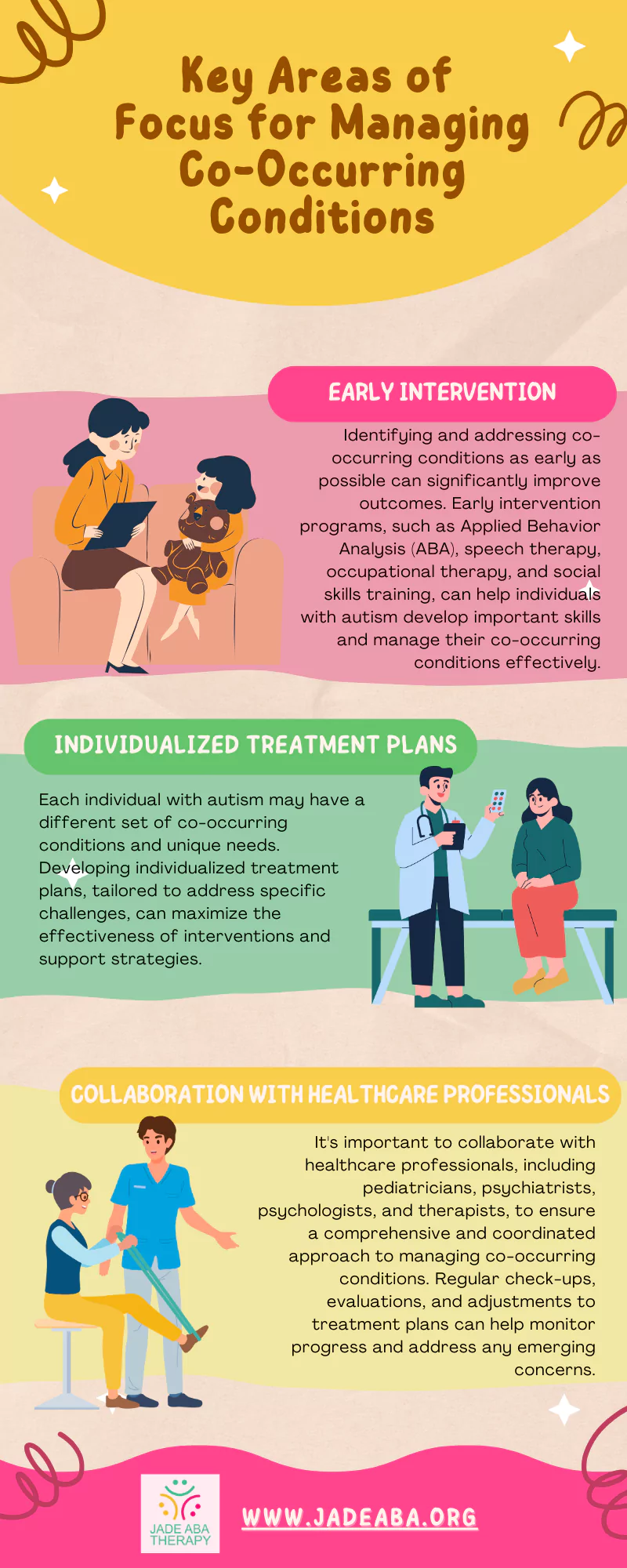Autism spectrum disorder (ASD) is often accompanied by a range of co-occurring conditions that can impact an individual’s overall health and well-being. Understanding these conditions and their prevalence in individuals with autism is crucial for providing appropriate support and interventions.
In this article, we will explore the concept of co-occurring conditions and the prevalence of these conditions in autism.

Understanding Co-Occurring Conditions
Co-occurring conditions refer to the presence of additional health conditions alongside autism. These conditions can manifest at any point in an individual’s life and may require additional attention and support to manage daily activities effectively.
Communication difficulties in individuals with autism can make it challenging to identify and diagnose these co-occurring conditions, emphasizing the need to address and treat them to enhance quality of life and functional abilities.
The presence of co-occurring conditions can vary widely among individuals with autism. Some common co-occurring conditions include mental health conditions, neurodevelopmental disorders, and medical conditions. It is important to note that each individual with autism may have a unique combination of co-occurring conditions, and the severity and impact of these conditions can vary significantly.

Prevalence of Co-Occurring Conditions in Autism
Research suggests that a significant proportion of individuals with autism experience co-occurring conditions.
Up to 95% of autistic children have been found to have at least one co-occurring condition, highlighting the high prevalence of these conditions in this population. Additionally, studies have shown that almost 75% of autistic individuals may live with another mental health condition or neurodevelopmental disorder.
Some specific co-occurring conditions that are frequently observed in individuals with autism include:
- Anxiety – Approximately 50% of autistic individuals experience anxiety, which can significantly impact their daily lives and functioning.
- Depression – Studies have indicated that 37% of autistic individuals have been diagnosed with a depressive disorder at some point in their lives. Autistic individuals are four times more likely to experience depression compared to their nonautistic peers.
- Obsessive-Compulsive Disorder (OCD) – OCD is also observed in autistic individuals, with around 5% of autistic young people diagnosed with this condition. OCD may contribute to higher levels of hoarding behavior in individuals with autism.
Understanding the prevalence of co-occurring conditions in autism is essential for developing comprehensive treatment plans and providing appropriate support to individuals with autism and their families.
By addressing these conditions alongside autism, it is possible to improve overall outcomes and enhance the quality of life for individuals on the autism spectrum.

Mental Health Conditions in Autism
Autism is a complex neurodevelopmental disorder that can often co-occur with various mental health conditions.
Let’s look at three common mental health conditions that are frequently linked to autism.
Anxiety
Anxiety is highly prevalent among individuals with autism, with approximately 50% of autistic people experiencing this condition. This is a significantly higher rate compared to the general population.
Anxiety disorders, such as social anxiety, can have a profound impact on the daily lives of individuals with autism.
Anxiety can manifest in various ways, including physical symptoms like a racing heart and muscle tightness. It can also contribute to difficulties in social interactions and communication. Behavioral interventions, such as cognitive-behavioral therapy, can be effective in managing anxiety in individuals with autism.
In some cases, anti-anxiety medications may also be prescribed to alleviate symptoms.
Depression
Depression is another mental health condition commonly experienced by individuals with autism. Research suggests that autistic individuals are four times more likely to experience depression compared to non-autistic individuals.
As mentioned earlier, approximately 37% of autistic people have been diagnosed with a depressive disorder at some point in their lives.
Depression can present with a range of symptoms, including persistent sadness, loss of interest in activities, changes in appetite or sleep patterns, and feelings of worthlessness. It is important for caregivers and healthcare providers to be vigilant in identifying signs of depression in individuals with autism.
Early intervention, such as therapy and medication, can help manage and alleviate depressive symptoms.
Obsessive-Compulsive Disorder (OCD)
Obsessive-compulsive disorder (OCD) is a condition characterized by intrusive thoughts (obsessions) and repetitive behaviors (compulsions). OCD is more prevalent among individuals with autism compared to the general population. Studies have found that around 5% of autistic young people have been diagnosed with OCD.
In individuals with autism, OCD may present with unique features, such as hoarding behaviors. These behaviors can be challenging to manage and may require specialized interventions.
Treatment for OCD in individuals with autism can involve a combination of behavioral therapies, such as exposure and response prevention (ERP), and medication under the guidance of a healthcare professional.

Neurodevelopmental Disorders in Autism
Autism is also often diagnosed alongside other neurodevelopmental disorders. Understanding these co-occurring conditions is essential for providing comprehensive care and support to individuals with autism.
Below are three neurodevelopmental disorders commonly linked to autism.
Attention-Deficit/Hyperactivity Disorder (ADHD)
Attention-Deficit/Hyperactivity Disorder (ADHD) is a neurodevelopmental disorder characterized by difficulties with attention, hyperactivity, and impulsivity. It is estimated that about 6.1 million (9.4%) of children between the ages of 2 and 17 years old were diagnosed with ADHD in 2016.
ADHD commonly co-occurs with autism, with studies suggesting that up to 50% of individuals with autism may also have ADHD. The symptoms of ADHD, such as difficulty sustaining attention, impulsivity, and hyperactivity, can further impact the daily functioning and social interactions of individuals with autism.
Managing the symptoms of both conditions requires a comprehensive approach that may include behavioral interventions and, in some cases, medication.

Dyslexia
Dyslexia is a learning disorder that affects reading ability and language processing. Autism and dyslexia share similarities in how the brain processes, stores, and retrieves information.
Due to these shared characteristics, individuals with autism may also receive a diagnosis of dyslexia. It is important to note that not all individuals with autism will have dyslexia, but the coexistence of these conditions can present unique challenges in the educational setting.
When dyslexia and autism co-occur, it is essential to provide targeted interventions that address the specific learning needs of the individual. These interventions may involve specialized reading programs, multisensory approaches, and individualized support to help individuals with autism and dyslexia thrive academically.
Fragile X Syndrome
Fragile X syndrome (FXS) is a genetic condition that affects intellectual and developmental functioning. It is one of the most common inherited causes of intellectual disability. Fragile X syndrome and autism often coexist, with a significant number of individuals with Fragile X syndrome also receiving a diagnosis of autism.
Children with Fragile X syndrome who also have autism may have a lower IQ compared to those with Fragile X syndrome without autism, indicating a compounded impact of the coexistence of these conditions.
Early intervention and specialized educational programs are crucial for optimizing the development and learning outcomes of individuals with both Fragile X syndrome and autism.

Medical Conditions in Autism
In this section, we’ll explore some of the most common medical conditions that are linked to autism. These are as follows:
Sleep Disorders
Sleep disorders are estimated to affect approximately 50-80% of individuals with autism. Sleep difficulties can include trouble falling asleep, frequent nighttime awakenings, and early morning awakenings.
These sleep disturbances can have a significant impact on both the individual with autism and their caregivers, leading to daytime drowsiness and behavioral challenges.
Epilepsy
Epilepsy, which is a neurological disorder characterized by recurrent seizures, is more prevalent among individuals with autism compared to the general population. Between 11 and 39% of individuals with autism are at risk of experiencing seizures. In contrast, epilepsy affects only 1 to 2 percent of the general population.
Red flags of epilepsy in individuals with autism can include staring spells, unusual postures, and rapid blinking.
It is important for individuals with autism to receive proper medical evaluation and care to manage epilepsy and its associated risks.
Gastrointestinal (GI) Disorders
GI disorders are significantly more common among children with autism compared to their neurotypical counterparts. These disorders can include issues such as chronic overeating leading to obesity, constipation, diarrhea, and the eating of non-food items (Pica).
Managing GI disorders in individuals with autism is crucial for their overall health and well-being.
How to Manage Co-Occurring Conditions in Autism
Managing co-occurring conditions in individuals with autism involves a multidisciplinary approach that considers the unique needs of each individual. This may include a combination of therapies, interventions, and support services.
The key areas of focus may include the following:

Behavioral Interventions
Behavioral interventions also play a crucial role in managing co-occurring conditions in individuals with autism. These interventions focus on modifying behaviors, developing coping strategies, and improving functional skills.
Some common behavioral interventions include:
- Applied Behavior Analysis (ABA) – ABA therapy uses behavioral principles to teach and reinforce desired behaviors while reducing challenging behaviors. It can be effective in addressing a wide range of co-occurring conditions, including anxiety, obsessive-compulsive disorder (OCD), attention-deficit/hyperactivity disorder (ADHD), and more.
- Cognitive-Behavioral Therapy (CBT) – CBT helps individuals identify and challenge negative thoughts and behaviors, promoting healthier thinking patterns and coping strategies. It can be beneficial for addressing conditions like anxiety and depression in individuals with autism.
- Social skills training – Social skills training programs aim to improve social interactions, communication, and relationship-building skills in individuals with autism. These programs can be valuable in addressing social anxiety and improving overall social functioning.
Medication Options for Co-Occurring Conditions
In some cases, medication may be prescribed to manage co-occurring conditions in individuals with autism. It’s important to note that medication should always be prescribed and monitored by a qualified healthcare professional.
It’s important to remember that medication should be used as part of a comprehensive treatment plan and in conjunction with other interventions. Regular monitoring, dosage adjustments, and close communication with healthcare professionals are essential to ensure the safe and effective use of medication.
By implementing these strategies and treatments, individuals with autism and their caregivers can work towards managing and minimizing the impact of co-occurring conditions, ultimately improving overall well-being and quality of life.